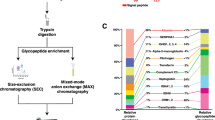Abstract
Blood group type glycosphingolipids present in kidneys of blood group A and B human individuals have been isolated and structurally characterized by mass spectrometry, proton NMR spectroscopy, degradation studies and by their reactivity with various monoclonal antibodies andEscherichia coli bacteria. The two major complex glycolipids present in the blood group A and B kidneys were globopentaosylceramide (IV3Galβ-Gb4Cer) and the X pentaglycosylceramide (III3Fucα-nLc4Cer). The major blood group A glycolipid in the blood group A kidneys was based on the type 4 chain (globo-series). There were also small amounts of the type 2 chain and trace amounts of the type 1 and type 3 chain based A glycolipids. In addition, the blood group H type 4 chain structure was present together with Lea and Leb compounds. In the blood group B kidneys, the major B glycolipids were monofucosylated hexa- and octaglycosylceramides, where the former were based on the type 2 carbohydrate chain. The blood group B type 4 chain heptaglycosylceramide was found to be a minor component making up only about 1% of the total blood group B structures.
Similar content being viewed by others
References
Makita A (1964)J Biochem (Tokyo) 55:269–76.
Mårtensson E (1966)Biochim Biophys Acta 116:296–308.
Mårtensson E (1969) InProgress in the Chemistry of Fats and Other Lipids (Holman RT, ed.) Vol X, part 4, pp 367–407. Oxford: Pergamon Press.
Rauvala H (1976)FEBS Lett 62:161–4.
Rauvala H (1976)J Biol Chem 251:7517–20.
Breimer ME, Samuelsson BE (1986)Transplant 42:88–91.
Rydberg L, Breimer ME, Samuelsson BE, Brynger H (1987)Transplant Proc 19:4528–37.
Breimer ME, Jovall PÅ (1985)FEBS Lett 179:165–72.
Breimer ME (1985)Glycoconjugate J 2:375–85.
Karlsson K-A (1987)Methods Enzymol 138:212–20.
Breimer M, Hansson GC, Karlsson K-A, Leffler H (1982)J Biol Chem 257:906–16.
Breimer ME, Hansson GC, Larson G (1983) InProc 7th Int Symp Glycoconjugates (Chester MA, Heinegård D, Lundblad A, Svensson S, eds) pp 421–2. Lund, Sweden: Secretariat.
Magnani JC, Smith DF, Ginsburg V (1981)Anal Biochem 109:399–402.
Hansson GC, Karlsson K-A, Larson G, McKibbin JM, Blaszczyk M, Herlyn M, Steplewski Z, Koprowski H (1983)J Biol Chem 258:4091–7.
Falk K-E, Karlsson K-A, Samuelsson BE (1979)Arch Biochem Biophys 192:191–202.
Ciucanu I, Kerek F (1984)Carbohydr Res 131:209–17.
Larson G, Karlsson H, Hansson GC, Pimlott W (1987)Carbohydr Res 161:281–90.
Karlsson K-A (1974)Biochemistry 13:3643–7.
Breimer ME, Hansson GC, Karlsson K-A, Leffler H, Pimlott W, Samuelsson BE (1979)Biomed Mass Spectrom 6:231–41.
Breimer ME, Hansson GC, Karlsson K-A, Larson G, Leffler H, Pascher I, Pimlott W, Samuelsson BE (1980)Adv Mass Spectrom 8:1097–108.
Stellner K, Saito H, Hakomori S (1973)Arch Biochem Biophys 155:464–72.
Breimer ME, Karlsson K-A, Samuelsson BE (1981)J Biol Chem 256:3810–6.
Le Pendu J, Lambert F, Samuelsson BE, Breimer ME, Seitz RC, Urdanitz MP, Suesa N, Murray R, Francois A, Poschmann A, Viñas J, Oriol R (1986)Glycoconjugate J 3:255–71.
Abe K, Levery SB, Hakomori S (1984)J Immunol 132:1951–4.
Bock K, Breimer ME, Brignole A, Hansson GC, Karlsson K-A, Larson G, Leffler H, Samuelsson BE, Strömberg N, Svanborg Edén C, Thurin J (1985)J Biol Chem 260:8545–51.
Rydberg L, Breimer ME, Samuelsson BE (1988)Transfusion 28:483–8.
Dabrowski J, Hanfland P, Egge H, Dabrowski U (1981)Arch Biochem Biophys 210:405–11.
Kannagi R, Levery SB, Ishigami F, Hakomori S, Shevinsky LH, Knowles BB, Soler D (1983)J Biol Chem 258:8934–42.
Dabrowski J, Hanfland P, Egge H (1980)Biochemistry 19:5652–8.
Karlsson K-A, Larson G (1981)J Biol Chem 256:3512–24.
Breimer ME, Karlsson K-A, Samuelsson BE (1982)J Biol Chem 257:1079–85.
Kannagi R, Levery S, Hakomori S (1984)FEBS Lett 175:397–401.
Karlsson K-A (1977)Progr Chem Fats Lipids 16:207–30.
Breimer ME, Karlsson H, Karlsson K-A, Nilsson K, Samuelsson BE, Strömberg N (1988)Carbohydr Res 178:111–20.
Levery SB, Nudelman ED, Andersen NH, Hakomori S (1986)Carbohydr Res 151:311–28.
Clausen H, Watanabe K, Kannagi R, Levery SB, Nudelman E, Arao-Tomono Y, Hakomori S (1984)Biochem Biophys Res Commun 124:523–9.
Clausen H, Levery SB, Nudelman E, Tsuchiya S, Hakomori S (1985)Proc Natl Acad Sci USA 82:1199–203.
Clausen H, Levery SB, Nudelman E, Baldwin M, Hakomori S (1986)Biochemistry 25:7075–85.
Rydberg L, Breimer ME, Brynger H, Samuelsson BE (1990)Transplant 49:954–60.
Hakomori S, Wang S-M, Young WW (1977)Proc Natl Acad Sci USA 74:3023–7.
Hakomori S, Young WW (1983) InSphingolipid Biochemistry (Kanfer JN, Hakomori S, eds) pp 381–436. New York: Plenum.
Schwarting GA, Carroll PG, DeWolf WC (1983)Biochem Biophys Res Commun 112:935–40.
Nagai K, Roberts DD, Toida T, Matsumoto H, Kushi Y, Handa S, Ishizuka I (1989)J Biol Chem 264:16229–37.
Leffler H, Svanborg-Edén C (1980)FEMS Microbiol Lett 8:127–34.
Källenius G, Möllby R, Svensson SB, Winberg J, Lundblad A, Svensson S, Cedergren B (1980)FEMS Microbiol Lett 7:297–302.
Senior D, Baker N, Cedergren B, Falk P, Larson G, Lindstedt R, Svanborg-Edén C (1988)FEBS Lett 237:123–7.
Lindstedt R, Baker N, Falk P, Hull R, Hull S, Karr J, Leffler H, Svanborg-Edén C, Larson G (1989)Infect Immunity 57:3389–94.
Breimer ME, Hansson G, Leffler H (1985)J Biochem (Tokyo) 98:1169–80.
Clausen H, Hakomori S (1989)Vox Sang 56:1–20.
Author information
Authors and Affiliations
Additional information
Abbreviations: for blood group glycolipid antigens the short hand designation stands for blood group—number of sugar residues—type of carbohydrate chain. Thus A-7-4 means a type 4 chain blood group A heptaglycosylceramide. The sugar types are abbreviated for mass spectrometry to Hex for hexose, HexNAc forN-acetylhexosamine and dHex for deoxyhexose.
Rights and permissions
About this article
Cite this article
Holgersson, J., Jovall, PÅ., Samuelsson, B.E. et al. Blood group type glycosphingolipids of human kidneys. Structural characterization of extended globo-series compounds. Glycoconjugate J 8, 424–433 (1991). https://doi.org/10.1007/BF00731294
Received:
Issue Date:
DOI: https://doi.org/10.1007/BF00731294




